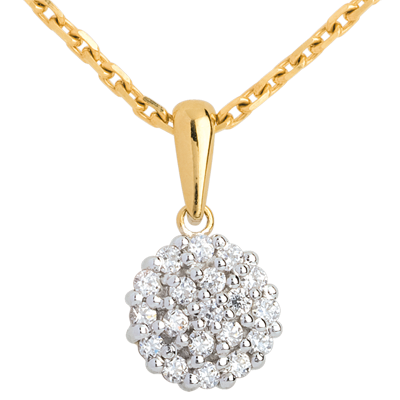The word diamond comes from the greek "adamas" which means indomitable, invincible and in reverence to long-lasting power. It is a mineral composed of pure carbon.
The History of Diamonds
The History
The first written document that refers to the diamond is a hindu manuscript dating to the IVth century B.C., but we think that the first deposits of diamonds began to be exploited in India since the VIIIth century A.D.
We don't know the exact date when diamonds found in India began to be distributed in the west. The precious stones were transported along the silk route discovered by Vasco de Gama in South Africa starting in the XVth century. Lisbon, Bruges and Venice became important commerical centres.
In the XVIth century, Antwerp became the main commerical centre, handling nearly half of the world's commerce in diamonds.
Although India was the only producer of diamonds until the XVIIIth century, one began to discover deposits of diamonds in Brazil and in the XIXth century, in South Africa.
Since then, most diamonds come from the African continent(about 60%). The 4 principal producers are currently : Botswana, the Congo, Russia and Australia.
Legends
The First Legends
In ancient Egypt, the diamond symbolised the sun. It was placed in the middle of the cross of life. In India, its durability led it to be valued as a talisman capable of warding off danger. It was thought to give warriors the strength necessary to win in combat.
The diamond thus became a symbol of masculinity reserved for men and one does not find any mention of diamond jewellery worn by women before the XVth century.
The Legend of The Valley of Diamonds
The legend goes that Alexander the Great discovered a valley at the heart of which lay countless diamonds. No one could enter the valley because it was guarded by snakes and eagles. The looks of these snakes being fatal, Alexander the Great used mirrors to kill them.
Then, to reach the diamonds that were at the heart of the valley, he threw pieces of mutton. The eagles carried back the meat studdied with diamonds to Alexander the Great and his soldiers.
Legends of Cursed Diamonds
We have often associated curses with the the famous diamonds like the Sancy, the Orlov, the Regent or the Hope. Their owners were known for a series of tragic fates.
 The Sancy is a pear-shaped diamond of 55,25 carats. It was said to be cursed because it belonged to a soldier who perished when the stone was mounted on his helmet, then to the count Nicolas Harlay of Sancy who entrusted his messenger with it, who was murdered by thieves, and finally to king Charles I, who was decapitated.
The Sancy is a pear-shaped diamond of 55,25 carats. It was said to be cursed because it belonged to a soldier who perished when the stone was mounted on his helmet, then to the count Nicolas Harlay of Sancy who entrusted his messenger with it, who was murdered by thieves, and finally to king Charles I, who was decapitated. 
The Orlov: this diamond of 189,60 carats with a blue-green shimmer was given by the Count of Orlov to the empress Catherine to reconquer her love. Unfortunately, his attempt to win her affection was in vain.
 The Regent: cushion-cut diamaond of 140,50 carats. It was stolen by a slave who sold it to a sailor so that he could escape from his ship. The legend says that the sailor lost his way.
The Regent: cushion-cut diamaond of 140,50 carats. It was stolen by a slave who sold it to a sailor so that he could escape from his ship. The legend says that the sailor lost his way. .jpg) The Hope: this cushion-shaped diamond with a blue colouring has a weight of 45,52 and is still considered baleful. It belonged to Louis XIV who only wore it once and died of small pox, then to Louis XV who lent it to Madame du Barry, who ended her days at the guillotine, then to Louis XVI, Marie Antoinette and princess Lambale who all met with tragic fates. The curse continued with the diamond maker who recut the diamond, only to suffer a violent death along with that of his son, an American jeweller who bought it and went bankrupt, a Russian prince who killed his wife to whom he had lent it, etc. The list of curses is unfortunately still long and the legend remains: some say that we can admire the Hope in Washington at the Smithsonian museum, others say it was aboard the Titanic when the ship sank...
The Hope: this cushion-shaped diamond with a blue colouring has a weight of 45,52 and is still considered baleful. It belonged to Louis XIV who only wore it once and died of small pox, then to Louis XV who lent it to Madame du Barry, who ended her days at the guillotine, then to Louis XVI, Marie Antoinette and princess Lambale who all met with tragic fates. The curse continued with the diamond maker who recut the diamond, only to suffer a violent death along with that of his son, an American jeweller who bought it and went bankrupt, a Russian prince who killed his wife to whom he had lent it, etc. The list of curses is unfortunately still long and the legend remains: some say that we can admire the Hope in Washington at the Smithsonian museum, others say it was aboard the Titanic when the ship sank...Jewellery
for Everyone
for Everyone
Accessible, inclusive, and universal
EVERY MONTH, EDENLY GIVES AWAY
A PIECE OF JEWELLERY WORTH £500
A PIECE OF JEWELLERY WORTH £500
or refund of your jewellery up to £500. All subscribers to our newsletter and followers of edenly.jewellery on social media are automatically entered into the draw.
Your email will never be marketed. By validating, you agree to the Edenly Privacy Policy. +info

Congratulations Silvia V. (Maisons-laffitte ) !
This month you win the necklace Abondance Nº23 in 9-carat yellow and white gold with diamonds.
